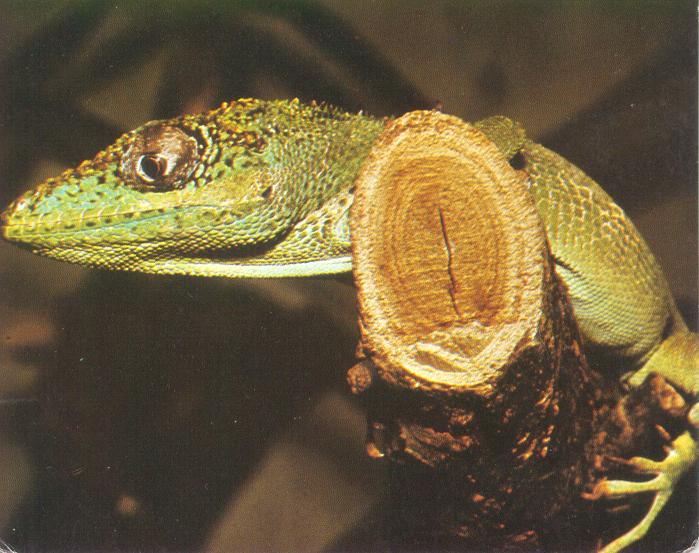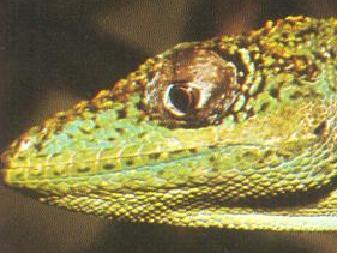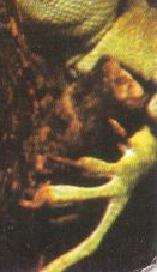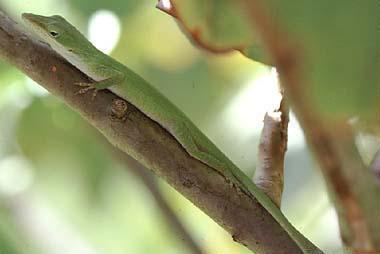The Anole
Also called the American chameleon

Anolis equestris

 You can see in the picture at the right those lop-sided, clawed iguana feet, which also have sticky pads of scales, which allow it to clamber up tree limbs, no matter how smooth they may be. The head shown at left has the scaled, independently movable eyes of a chameleon, but the head itself is long and slender, unlike a chameleon. Anoles were, in fact, once classified in the family Iguanidae, but were recently given their own family: Polychrotidae, meaning "multi-colored."
You can see in the picture at the right those lop-sided, clawed iguana feet, which also have sticky pads of scales, which allow it to clamber up tree limbs, no matter how smooth they may be. The head shown at left has the scaled, independently movable eyes of a chameleon, but the head itself is long and slender, unlike a chameleon. Anoles were, in fact, once classified in the family Iguanidae, but were recently given their own family: Polychrotidae, meaning "multi-colored."
The color changing ability of the anole is limited, but breath-taking nonetheless. Defensively, anoles usually camouflage themselves in greens and browns, but I've seen them take on vivid blues and deep purples, and even, under extreme duress, a deep jet black. They seem to do this unconsciously, taking on the color of whatever background they happen to be on, or even changing color according to mood.  They seem more likely to be green when relaxed, and brown when provoked or pursued. The males have a large throat pouch or dewlap, which they will extend like a flag when another male appears. They flatten their bodies laterally and turn their side to the rival, making themselves appear as large and threatening as possible, all the while bouncing up and down on their front legs. The dewlap is usually red beneath the white underscales, giving a pink appearance, but can be dappled with blues, greens, and yellows. I've even seen male anoles display at their own images in a mirror!
They seem more likely to be green when relaxed, and brown when provoked or pursued. The males have a large throat pouch or dewlap, which they will extend like a flag when another male appears. They flatten their bodies laterally and turn their side to the rival, making themselves appear as large and threatening as possible, all the while bouncing up and down on their front legs. The dewlap is usually red beneath the white underscales, giving a pink appearance, but can be dappled with blues, greens, and yellows. I've even seen male anoles display at their own images in a mirror!
By far, though, the most amazing ability of the anole is its extreme agility. It is capable of lightning-fast movement, scrambling up limbs and even launching themselves through the air faster than the eye can follow, snagging a new limb or leaf with their special feet.
Anoles can achieve lengths up to nearly two feet in the wild (Anolis equestris), but most domestic anoles (Anolis carolinensis) are ten inches or less, making them perfect pets. However, most domestic anoles are handled excessively, which puts a lot of stress on the animals. Stress is a major killer for reptiles, so most of these scaly house-pets never achieve their maximum lifespan of six years, dying young at two years or less.

|
Prolific, aren't they?